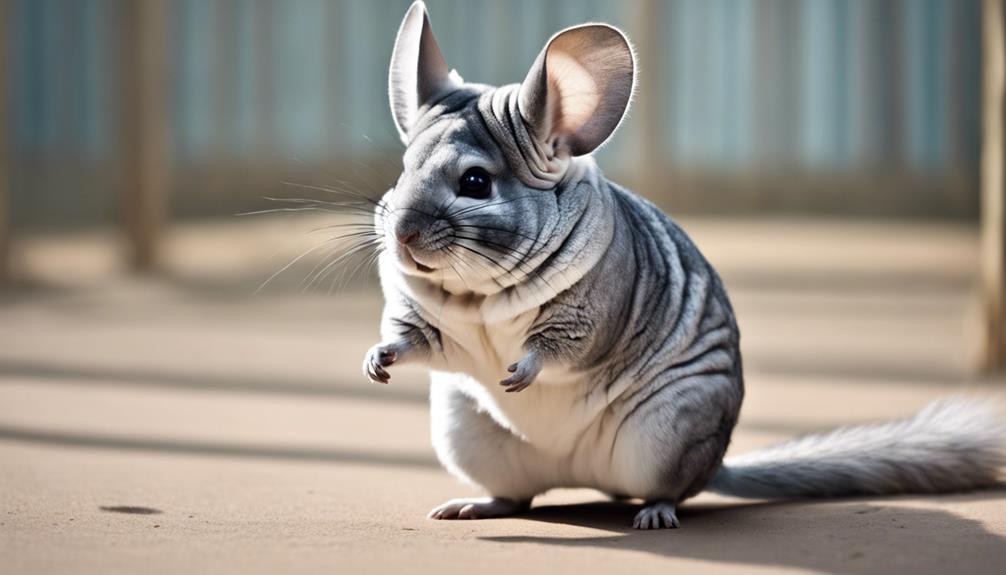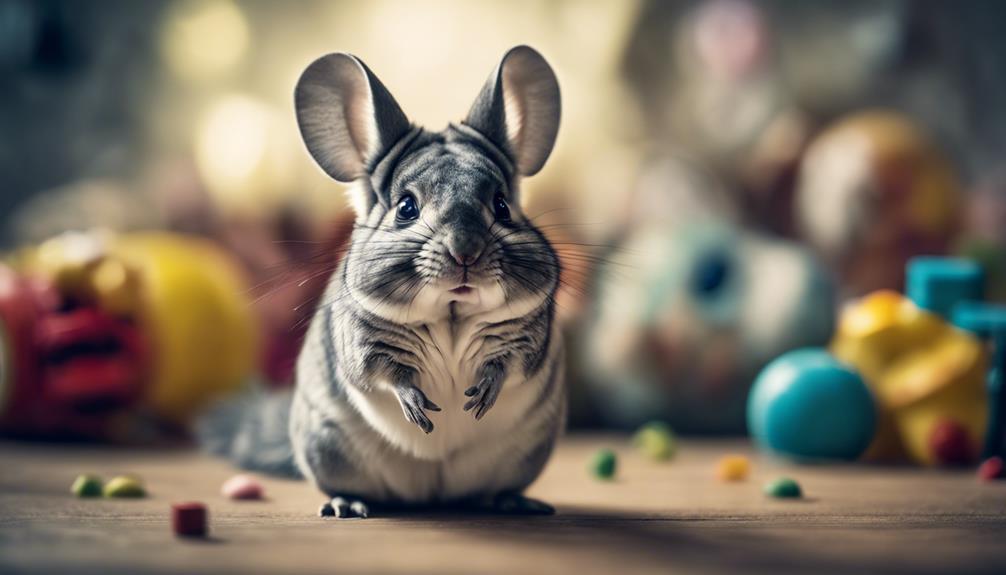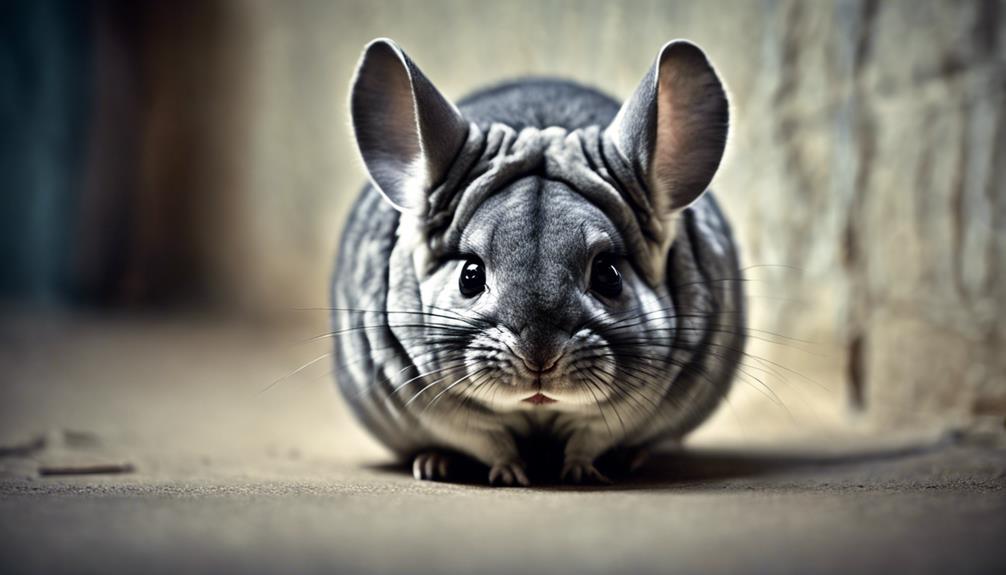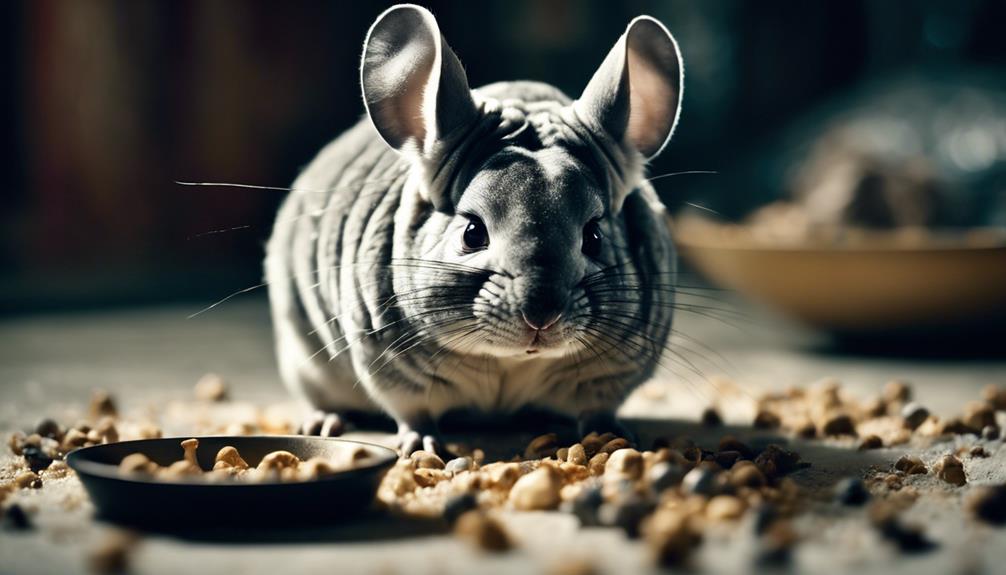What to Do When a Chinchilla Exhibits Strange Behavior

Chinchillas are unique pets that exhibit some strange behaviors. Understanding these behaviors is essential for ensuring the well-being of your pet chinchilla. Here are some tips to help you decipher and address these unusual actions:
- Dust Bathing: Chinchillas love to roll around in dust to maintain their fur’s health. Providing a dust bath regularly is crucial for their grooming routine.
- Chewing Everything: Chinchillas have continuously growing teeth that need to be worn down. Providing safe chew toys will prevent them from damaging furniture or other items in your home.
- Nocturnal Nature: Chinchillas are most active during the night. Understanding and respecting their nocturnal behavior is essential for their mental and physical health.
- Tail Wagging: Chinchillas may wag their tails when they are excited or feeling playful. It’s a sign of their happiness and should be encouraged with interactive toys and playtime.
- Fur Slip: When stressed or frightened, chinchillas may release a patch of fur to escape from a predator’s grasp. Creating a calm and secure environment will help prevent this behavior.
By recognizing and addressing these strange behaviors, you can ensure that your pet chinchilla remains healthy, happy, and well-adjusted.
Signs of Strange Behavior
When observing chinchillas, it’s crucial to be attentive to signs of strange behavior that may indicate underlying health or environmental concerns. Behavioral cues such as excessive chewing on cage bars, fur pulling, or sudden aggression towards cage mates can be stress indicators. These unusual actions should serve as warning signs prompting immediate attention.
Chinchillas are known for their gentle and social nature, so any deviation from their usual behavior could signal a problem. If a typically active chinchilla suddenly becomes lethargic or hides more frequently, it may be experiencing stress or discomfort. Other warning signs include changes in appetite, excessive vocalization, or repetitive movements like pacing.
As caretakers, it’s essential to monitor chinchillas closely and intervene promptly if any abnormal behaviors are noticed. Providing a safe and enriching environment, along with regular veterinary check-ups, can help address underlying issues and ensure the well-being of these adorable creatures.
Understanding Chinchilla Body Language

Chinchillas, like many animals, use body language to communicate their needs and emotions. Understanding their subtle gestures can provide insight into their well-being and help strengthen the bond between chinchilla and owner.
Signs of distress, in particular, can be crucial to recognize early to ensure the chinchilla’s health and happiness.
Body Language Signals
Observing a chinchilla’s body language can provide valuable insights into their emotions and intentions. When understanding chinchilla body language, keep these key points in mind:
- Communication cues: Chinchillas use various non-verbal signals to express their feelings, such as ear positioning and tail movements.
- Social cues: Their body language interpretation often conveys their social interactions and hierarchy within a group.
- Eye contact: Direct eye contact may indicate aggression or dominance.
- Posture: Pay attention to their body posture, as hunched or flattened bodies can signal fear or submission.
Communication Through Gestures
Understanding chinchilla body language involves interpreting their subtle gestures and movements to gain insight into their emotions and intentions. Chinchillas use nonverbal communication as a primary means to express themselves.
By observing their gestures and signals, such as ear positioning, tail movement, and body posture, you can better understand their current state of mind. For example, flattened ears and a puffed-up tail may indicate fear or stress, while relaxed body language signifies contentment.
Paying attention to these cues allows caretakers to respond appropriately to their chinchilla’s needs, creating a deeper bond based on trust and understanding. By being attuned to their gestures and signals, you can ensure a harmonious relationship with your furry companion.
Signs of Distress
Interpreting a chinchilla’s body language can provide valuable insights into their well-being, especially when it comes to recognizing signs of distress. Chinchillas may exhibit stress indicators through their behavior, signaling the need for behavior modification. Understanding their body language is crucial in identifying when they’re in distress or discomfort.
If you notice any unusual behaviors, such as excessive hiding, aggression, or changes in eating habits, it may be a sign that your chinchilla is experiencing distress. In such cases, seeking veterinary consultation is recommended to address any underlying health issues promptly.
Potential Reasons for Odd Actions

Noticing unusual behaviors in your chinchilla can be a source of concern, but delving into the underlying causes can often shed light on their actions. There are several factors that could contribute to odd actions in chinchillas, including stress indicators, behavioral triggers, environmental influences, and health concerns.
Potential Reasons for Odd Actions
Here is a table summarizing the potential reasons for odd behavior in chinchillas:
| Factors | Possible Reasons |
|---|---|
| Stress indicators | Loud noises, sudden changes in routine, overcrowded living space, lack of enrichment |
| Behavioral triggers | Lack of social interaction, boredom, fear of predators, past traumas |
| Environmental influences | Poor air quality, extreme temperatures, inadequate lighting, uncomfortable bedding |
| Health concerns | Dental issues, digestive problems, parasites, infections |
Handling Aggression and Fear

When faced with aggression and fear in chinchillas, it’s essential to approach the situation calmly and with a deep understanding of their behavior patterns and triggers. Chinchillas, like all animals, may exhibit aggression or fear due to various reasons, and it’s crucial to address these issues with care and patience.
Here are some tips to help manage aggression and fear in chinchillas:
- Create a Safe Environment: Ensure the chinchilla’s habitat is secure and provides hiding spots for when they feel threatened.
- Implement Behavior Modification Techniques: Use positive reinforcement to encourage desired behaviors and discourage aggressive tendencies.
- Reduce Stress Factors: Minimize loud noises, sudden movements, or other stressors that may trigger fear or aggression in chinchillas.
- Seek Professional Guidance: If the chinchilla’s behavior doesn’t improve, consult with a veterinarian or an animal behaviorist for further assistance in aggression management and fear control.
Dealing With Excessive Vocalizations

Chinchillas are known for their vocal nature. Excessive vocalizations can sometimes indicate underlying issues. Understanding the reasons behind these vocalizations is crucial for effective intervention.
Noise Level Control
To address excessive vocalizations in chinchillas, owners can implement various techniques for noise level control. Chinchillas are naturally vocal animals, but persistent loud vocalizations could indicate stress or discomfort. Here are some strategies to help manage noise levels and ensure your chinchilla’s well-being:
- Training methods: Utilize positive reinforcement techniques to encourage quiet behavior.
- Behavior modification: Identify and address any underlying issues that may be causing excessive vocalizations.
- Environmental enrichment: Provide plenty of toys, hiding spots, and opportunities for exercise to keep your chinchilla mentally stimulated.
- Vocalization control: Establish a consistent daily routine and ensure your chinchilla gets enough rest to minimize unnecessary noise.
Communication Understanding
Understanding your chinchilla’s communication cues, especially when dealing with excessive vocalizations, is crucial for maintaining a strong bond and ensuring their overall well-being. Behavior analysis is key to interpreting the reasons behind your chinchilla’s increased vocalizations. Chinchillas can vocalize due to various reasons such as stress, discomfort, or seeking attention.
By observing their body language and other communication signals, such as ear position and vocalization patterns, you can gain insight into their emotional state. Engaging with your chinchilla through gentle interactions and providing a stimulating environment can help alleviate excessive vocalizations. Remember, each chinchilla is unique, so patience and understanding are essential when deciphering their communication cues.
Behavioral Modification Techniques
When addressing excessive vocalizations in chinchillas, implementing positive reinforcement techniques can be effective in modifying their behavior. Positive reinforcement focuses on rewarding desired behaviors to encourage their repetition.
Here are some techniques to help with chinchillas exhibiting excessive vocalizations:
- Reward Quiet Moments: Offer treats or gentle pets when the chinchilla is quiet.
- Use Distraction: Provide toys or activities to redirect their focus and reduce vocalizations.
- Establish a Routine: Chinchillas thrive on predictability, so creating a consistent daily schedule can help minimize stress-induced vocalizations.
- Seek Professional Guidance: If excessive vocalizations persist, consult with a veterinarian or animal behaviorist for further assistance in behavior modification.
Implementing these positive reinforcement techniques can help address and reduce excessive vocalizations in chinchillas effectively.
Addressing Changes in Eating Habits

If your chinchilla suddenly shows changes in its eating habits, it is important to observe and address this behavior promptly to ensure its well-being. Eating pattern changes could indicate nutritional deficiencies, weight loss, or dental problems. It is crucial to monitor your chinchilla’s food intake daily to notice any deviations from its regular eating habits. Here are some steps to address changes in eating habits:
| Steps to Address Changes in Eating Habits | Description |
|---|---|
| Monitor Food Intake | Keep track of what your chinchilla eats daily. |
| Offer a Variety of Foods | Provide a balanced diet to prevent deficiencies. |
| Check for Dental Issues | Examine your chinchilla’s teeth for any problems. |
| Consult a Vet if Necessary | Seek professional advice if the issue persists. |
Seeking Veterinary Advice

Addressing changes in your chinchilla’s eating habits is crucial for their well-being; however, if the issue persists despite your efforts, seeking veterinary advice is paramount to ensure your chinchilla’s health.
When considering seeking veterinary advice for your chinchilla exhibiting strange behavior, keep in mind the following essential points:
- Consultation Process: Schedule a consultation with a knowledgeable exotic animal vet who’s experience with chinchillas to discuss your concerns thoroughly.
- Treatment Plans: The vet will assess your chinchilla’s condition and create a personalized treatment plan tailored to address the specific behavioral issues.
- Medication Options: Depending on the diagnosis, the vet may recommend medication options to help manage any underlying health issues contributing to the strange behavior.
- Behavioral Therapy: In addition to medication, behavioral therapy techniques may be suggested by the vet to modify your chinchilla’s behaviors effectively.
Frequently Asked Questions
Can Chinchillas Exhibit Signs of Stress or Anxiety Through Their Behavior?
Chinchillas can indeed display signs of stress or anxiety through their behavior. This can manifest in various ways, such as excessive grooming, cage pacing, or changes in appetite. Providing adequate cage enrichment and a calming environment is crucial.
What Are Some Common Signs of Boredom in Chinchillas and How Can It Be Addressed?
When chinchillas display signs of boredom, it’s crucial to provide mental and physical stimulation. Enrichment ideas like interactive toys can keep them engaged. Behavioral training and understanding chinchilla communication help foster a happy and healthy environment.
How Can Chinchilla Owners Prevent Territorial Behavior in Their Pets?
To prevent aggression in chinchillas, owners should focus on socialization techniques. Introduce chinchillas to each other gradually, provide ample space, and ensure they have separate feeding and sleeping areas. Consistent positive interactions can help reduce territorial behavior.
Is It Normal for a Chinchilla to Suddenly Become More Vocal and Attention-Seeking?
It is not unusual for a chinchilla to suddenly become more vocal and attention-seeking. This behavior may indicate a need for interaction or environmental enrichment. Exploring positive training techniques and providing behavioral enrichment can help address these needs.
Are There Any Specific Warning Signs That Indicate a Chinchilla May Be Experiencing Health Issues Rather Than Behavioral Problems?
When monitoring chinchilla health, specific warning signs like changes in appetite, lethargy, or abnormal stool indicate potential health issues over behavioral problems. Recognizing these signals promptly and consulting a vet can help address concerns effectively.










